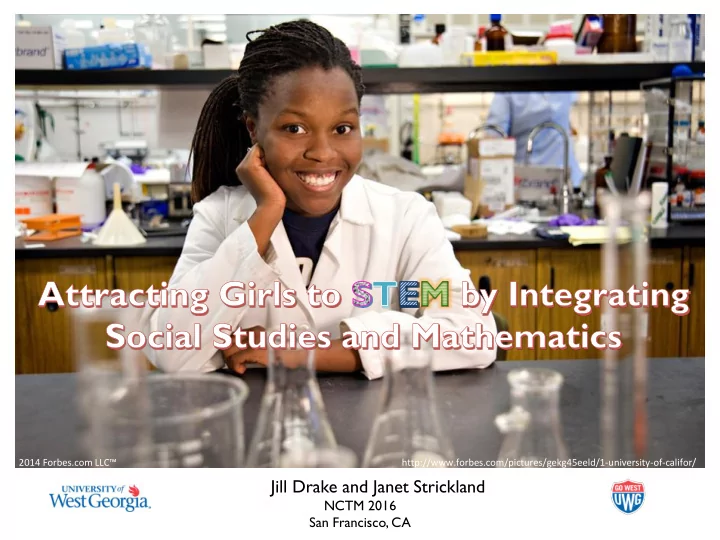

2014 Forbes.com LLC™ http://www.forbes.com/pictures/gekg45eeld/1-university-of-califor / Jill Drake and Janet Strickland NCTM 2016 San Francisco, CA
What we are learning from gender research ? Interests form at an early age and remain fundamentally stable from age 12 to age 40 • for both females and males (Low, Yoon, Roberts, & Rounds, 2005). • Gender disparities in interest in STEM fields can be seen as early as elementary school (Hill, Corbett, Rose, et al., 2010). • Females with high math aptitude are less interested in math-intensive careers than males with comparable aptitude (Lubinski & Benbow, 2006). • Among males and females of comparably outstanding mathematical aptitude, females are more likely to also have outstanding verbal ability giving them greater career options. (Park et al., 2008). • Women have been found to prefer people-oriented careers over things-oriented careers and these preferences may contribute to the underrepresentation of women in STEM fields. (Su, Rounds, & Armstrong, 2009). The Lemonade War Book Give-Away • Females tend to have more Artistic, Social, and Conventional interests (Su, Rounds, & Armstrong, 2009). • Females’ perceptions that work in STEM fields is solitary (versus collaborative) and competitive (versus cooperative) work appears to mediate the relationship between their field-specific ability beliefs and female representation in STEM fields (Meyer, Cimpian, & Jane Leslie, 2015).
The integration of social studies and mathematics education at the elementary school level is a well- suited approach to combat girls’ lack of interest in STEM careers.
Five Strategies for Integration and Increased Interest in STEM Debunk STEM stereotypes and misconceptions through studying diverse, women role models (past and present). Illustrate the social and artistic aspects of STEM fields through literature and interdisciplinary learning tools and activities. Highlight STEM careers that are contribute students’ historical, geographical, civic, and economic understandings of our society. Reinforce the role of collaboration in STEM fields through engagement in engineering design task centered on social justice issues. Engage students in writing across the curriculum.
Debunk STEM stereotypes and misconceptions through studying women role models (past and present) Book Give-Away Ada Lovelace - Ada, Countess of Lovelace ( née Byron ; 10 December 1815 – 27 November 1852) was an English mathematician and writer, chiefly known for her work on Charles Babbage's early mechanical general-purpose computer, the Analytical Engine. Her notes on the engine include what is recognized as the first algorithm intended to be carried out by a machine. As a result, she is often regarded as the first computer programmer . Annie J. Easley (April 23, 1933 – June 25, 2011) was an African- American computer scientist, mathematician, and rocket scientist. [1] She worked for the Lewis Research Center of the National Aeronautics and Space Administration (NASA) and its predecessor, the National Advisory Committee for Aeronautics (NACA). She was a leading member of the team which developed software for the Centaur rocket stage and one of the first African-Americans in her field. Resource for learning about Women in STEM http://staging.forgirlsinscience.org/women-in-stem/
Illustrate the social and artistic aspects of STEM disciplines through literature and interdisciplinary learning tools and activities. • Coding Lesson with Jewelry http://www.nativetech.org/games/index.php Wampum Belt (Addition, Subtraction, Fractions, Percentages)
STEM for Girls Math and Art Evolution of Calpernia Pinterest Tate STEM Women Aims 1. Make women in STEM more visible to the public, with a special focus on women scientists on Google+ 2. Promote careers for women in STEM 3. Highlight issues of gender inequality 4. Address solutions to improve women’s participation, inclusion, leadership and recognition in STEM
Highlight STEM careers that and contribute students ’ historical, geographical, civic, and economic understandings of societies. Resource: 21 Seriously Cool Career that Need Mathematics • http://startingwright.cs.wright.edu/Teacher/ingut/21-seriously-cool-careers.pdf Resource: Culturally Situated Design Tools http://csdt.rpi.edu/ •
Reinforce the role of collaboration in STEM fields through engagement in engineering design task and math lessons centered on social justice issues. Social studies and history set the context for engineering challenges. http://www.radicalmath.org/
Engage students in reading and writing across the curriculum. • ReadWorks.org - ReadWorks is a leading national non-profit organization that provides FREE, research-based, and Common Core-aligned reading comprehension curriculum. The ReadWorks curriculum is based on the most highly regarded, proven research on reading instruction, and includes: • Informational and literary passages and question sets for grades K-12 • Skill and Strategy lesson units for grades K-4 • Comprehension units for grades K-5 • Novel study units for grades 5-6
Other resources Women in STEM Publications • White House Fact Sheet: Women and Girls and Science, Technology, Engineering, and Mathematics • White House Fact Sheet: STEM Depiction Opportunities US Department of Commerce: Women in STEM: A Gender Gap to Innovation • New York Times: Why Are There Still So Few Women in Science? • New York Times: How Elementary School Teachers’ Biases Can Discourage Girls • from Math
References Ceci, S.J., & Williams, W.M. (2010). The mathematics of sex: How biology and society conspire to limit talented women and girls. NY: Oxford University Press. Hill, C., Corbett, C., St. Rose, A., & American Association of University, W. (2010). Why So Few? Women in Science, Technology, Engineering, and Mathematics . American Association Of University Women. Low, K. S. D., Yoon, M., Roberts, B. W., & Rounds, J. (2005). The stability of vocational interests from early adolescence to middle adulthood: A quantitative review of longitudinal studies. Psychological Bulletin, 131, 713 – 737. Lubinski, D., & Benbow, C. P . (2006). Study of Mathematically Precocious Youth (SMPY) after 35 years: Uncovering antecedents for the development of math-science expertise. Perspectives on Psychological Science, 1, 316-343. Meyer, M., Cimpian, A., & Leslie, S. (2015). Women are underrepresented in fields where success is believed to require brilliance. Frontiers In Psychology , 61-12. doi:10.3389/fpsyg.2015.00235 Park, G., Lubinski, D., & Benbow, C.P . (2008). Ability differences among people who have commensurate degrees matter for scientific creativity . Psychological Science , 19, 957 – 961. Su, R., Rounds, J., & Armstrong, P . I. (2009). Men and Things, Women and People: A Meta-Analysis of Sex Differences in Interests. Psychological Bulletin, 135(6), 859-884.
Recommend
More recommend